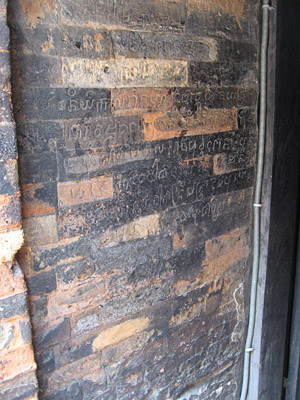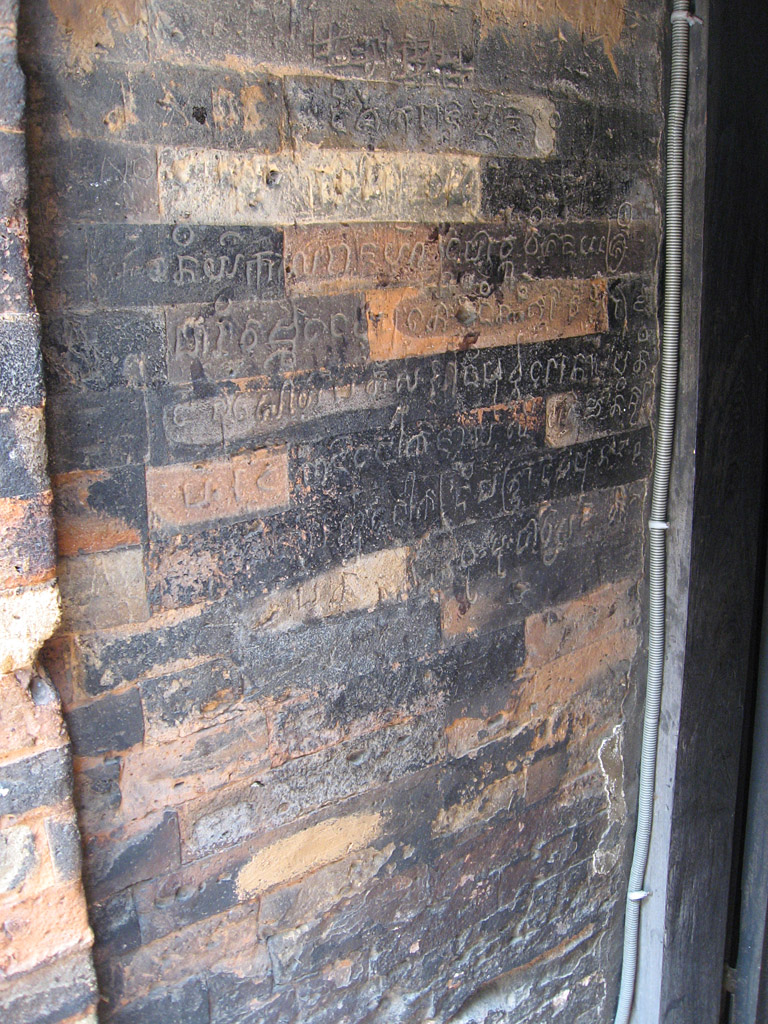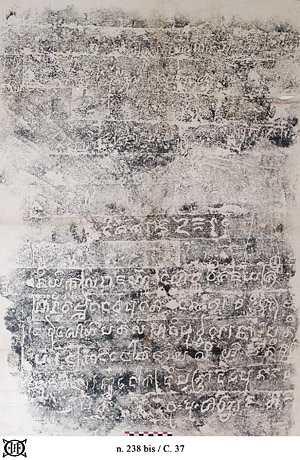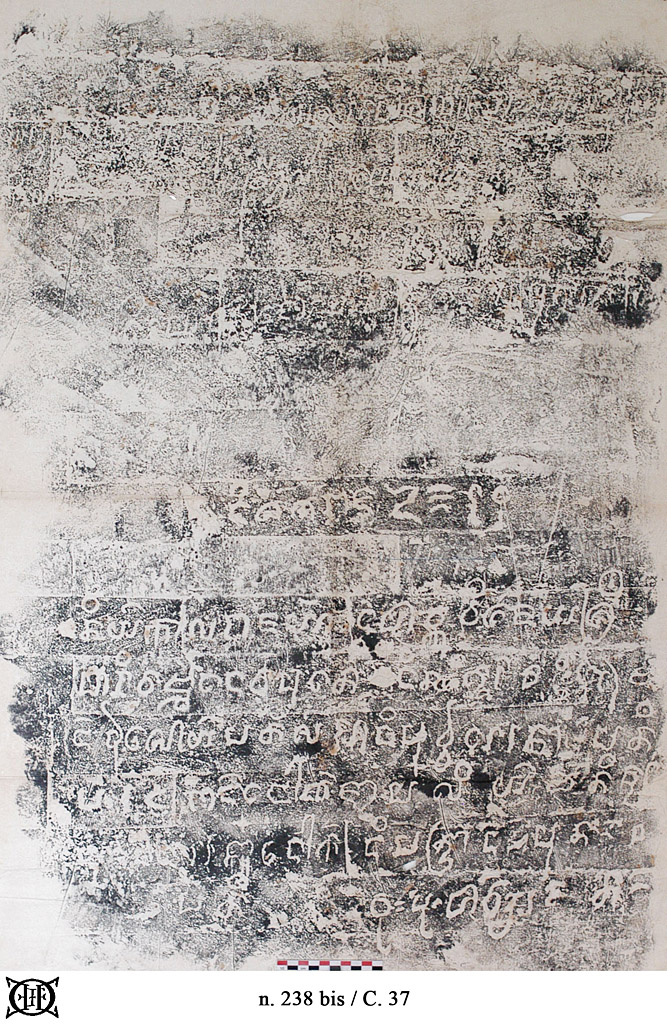Corpus of the Inscriptions of Campā




C. 37 Southern wall of the vestibule of the northwestern tower of Po Nagar
Please note: you are reviewing a preprint version of this publication. Contents here may change significantly in future versions. Scholars with specific interests are urged to consult all cited bibliography before using our texts and translations or drawing other significant conclusions.
Text Eleven lines engraved on the southern wall of the vestibule of the northwestern tower of Po Nagar temple. Written in Old Cam.
Date 935 Śaka (1013/4 CE).
Origin Temple of Po Nagar at Nha Trang (Khánh Hoà, Vietnam).
This inscription was found in situ before 1888, when it was first mentioned in Bergaigne 1888: 76-77. We identified the inscription on the temple site in 2009.
Edition(s) Figures have been read in Bergaigne 1888: 76-77; partially translated into French, in Aymonier 1891: 23-24; whence, summarized in English, in Majumdar 1927: 61; whence Golzio 2004: 52 and again with French translation in Schweyer 2005a: 116. The present edition and translation after ECIC III: 462-463 where we have re-edited the text from the inked EFEO estampage.
Facsimiles
- Estampage: BnF 410 (46)
- Estampage: EFEO 23
- Estampage: EFEO n. 238
The following text was edited by Arlo Griffiths and Amandine Lepoutre.
5 935 ◇ 735. Schweyer. — 5-6 nī niy· ◇ as suggested by the text of C. 125 (edition and traslation in Schweyer 2005a: 116), which is almost entirely identical, the notation nī niy· is probably a kind of dittography. — 6 kāla ◇ kala Schweyer. perhaps a typo. — pov ku vijaiya ◇ poṅ ciyei viśajaya Schweyer. with regards to the shape of the writing ai, which A.-V. Schweyer did not recognized, see C. 3.1 part A, ll. 2, 5 and -2 and l. 11 of the present inscription. — 8 maṅ· ◇ mad Schweyer. the use of the synonym nariy "since" in the parallel inscription C. 125 confirms what is graphically clear, namely that the reading must be maṅ. — patam̃l· ādipurvva ◇ patāl ādi pūrvva Schweyer. — 9 pam̃r· rauṅ· ◇ pārrauṅ Schweyer. — 10 sanā ◇ [di nagara]sanā Schweyer. in front of sanā, one can see some marks of letters diligently released. Concerning the word sanā, we speculate that it corresponds to the Malay word sana "there" (written sāna in Old Malay, see: Vikør 1988: 69 and 82). Given the possible presence of an anusvāra-candra above nā, one can also read sanām̃ "glad, pleased" (Aymonier & Cabaton 1906: 474). — 10-11 capatī ◇ [se]nāpatī Schweyer. line 10, we do not see any signs before patī; the last visible sign line 10, neglected by Schweyer, seems to be a ca. — 11 pov(· )an(ai)ḥ ◇ pāv [·] janaḥ Schweyer. Bergaigne 1888: 76 had read at the end of the text “une addition postérieure avec trois chiffres, apparemment encore une date, que je lis 824”. After Bergaigne, researchers considered that there is no addition, and we are of the same opinion.
Translations
English
In [the year] of the Śaka king 935. This was the time when Y.P.K the victorious Śrī Harivarmadeva ruled the country of Campā from Rūlauy to the Far East; where Paṅrauṅ; where Paṅrauṅ (native) of Dauk Jā in the area (paliy) of Manicya was general there; where (the latter) was at Panrāṅ: where he restored (punaḥ) the capatī and gave (the image of) his highness the little [goddess].
French
En [l'année] 935 du roi des Śaka. Ceci fut le temps où Y.P.K. le victorieux Śrī Harivarmadeva régnait dans le pays du Campā depuis Rūlauy jusqu'à l'extrême-orient; où Paṅrauṅ (originaire) de Dauk Jā dans l'agglomération (paliy) de Manicya fut général là-bas; où (ce dernier) siégeait à Panrāṅ: où il a restitué (punaḥ) le capatī et donné (l'image de) son altesse la petite [déesse].



Due to paleographical reasons, and others link to the kind of formulary it uses, it seems impossible that the commonly accepted date (735 Śaka), which correspond to the first quarter of the 9th century AD, is correct (see ECIC III: 481-487).
Our inpertretation of Dauk Jā as a toponym is based on parallel with the sanskrit inscription C. 31 C2 (engraved not on the hall's south wall Schweyer 2005a: 104 but on the interior face of the north doorjamb of Po Nagar temple's main tower in Nha Trang), l. 9: daukjāmahāgrāme.
In order to find out which object capatī designates, one note that C. 125 and C, 37 are parallels, except for the (purpose of) the registred deed. Following Schweyer 2005a: 116, the latter is vuḥ kalañ niy in C. 125. This reading reminds her an architectural term kalan (Parmentier 1909: 17). Then, she translated “je donne cette tour [kalan]”, assimilating kalan with kalañ. As we read vuḥ kalañca niy·, there is no reason to believe that capatī is un architectural element. Hypothetically, one can attempt to correlate (either by changing the reading or by implying a linguistic change in the History of Cham language (where fluctuations of t/k at the end of a word are known) between this word and capak/cāpak "betel box" in modern Cham (Aymonier & Cabaton 1906: 124).The donation/restitution of such an object, used for the deity cult, is wellknown in the epigraphy of South and Southeast Asia. Potentially, kalañca evokes the sanskrit word kalaśa "ewer", but we will not getting into this identification.